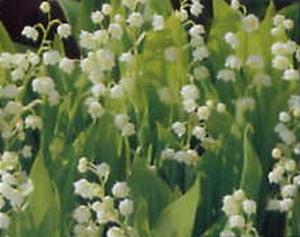Lily of the Valley, or Convallaria majalis to botanists, is a dainty yet cute flower to grow. Similar in flowering growth to the Bleeding Heart plant, these florets droop off the stems they grow out on. Sometimes confused with being a hosta, Lily of the Valley’s flowers are upside down bell shaped, and most are white in color. This plant is sometimes referred to as Lady’s Tears. Growing these can be frustrating when you do not know what to do. Do note that all parts of this plant are poisonous.
Often grown in the “English Garden,” Lily of the Valley is a gardener’s answer to filling in for color where there is much shaded areas. Sometimes, but not always, you may find this flower mixed in with hostas, bleeding heart and ferns. Ferns are more widely used with this plant in gardening since they require little sun as well. Partial shade is okay, but don’t let direct sun on these fair weathered flowers. You can easily dry them out.
Lily of the Valley requires moist soil. You will need to acclamate the soil with peat moss and loam. Clay soils are also okay. Make sure you feed the plants every ten to fourteen days if you do plant in clay. Should you be starting from scratch use some sandy Miracle Grow mixture for acidic plants. This will ensure healthy plant growth.
Seeds are not going to be found with these particular scented flowers. You can get them in rhizomes. These are similar to bulbs, but they actually send out leeders underground and back up for more plants. DO follow planting instructions for these flowers. They can grow just as prolithic as Autumn Fern. Be on the lookout for growth elsewhere in your garden or yard. This is the only drawback to planting Lily of the Valley.
Plant the rhizomes sixteen to twenty-four inches apart. Yes, they will take over. Lily of the Valley will grow up to twelve inches tall depending on the variety. You may ask the gardener you purchase these from how tall yours will grow. The rhizomes need not to be planted and deeper than three inches. Personally, if you do not have any growth on them, you can plant them as deep as four inches. This will protect them during the winter. Lily of the Valley is a spring and early summer plant. Keeping it cool during the summer’s heat may allow it to bloom on through fall.
When the flowers and foliage have died away, you can cut them down to the ground and they will grow back the following year. Wait until they have completely died back for the winter before you do this. Every two to three years you will need to dig them up after the last frost. Divide them so that these plants do not crowd each other out. They would be fighting for nutrients in the soil if you do not do this.
Lilly of the Valley can be grown indoor as many gardeners will do this. Their fragrance is one that will soon become recognizeable to you. There is a soft pink variety that you can also plant, but they sell quickly. You may want your local nursery to put you on a waiting list for them. Kitchen windows, foyer tables, or anywhere else indoors you want to grow Lily of the Valley will brighten up your home. Choose wisely so that you don’t have the plant in direct sun.
Be careful to not overwater these plants as it can be done. You may want to wait a few days in between waterings. Plant food is not all that necessary unless planted in clay as mentioned earlier, but it would not hurt. Since this is a delicate plant, do not try to force it to bloom. Upon the initial planting of Lily of the Valley water it with a mixture of root stimulator. You may only need to do this once more after a month of growth.
Utilizing hanging baskets for decorating your porch with lily of the valley is a great idea. The only catch to this is to make sure that the soil can actually drain out the water. Some hanging baskets do not have a water drain hole in them. Pay attention to that when attempting a project like this. Window boxes on the north side of the house would be a great idea, too.
Whether you are a new or seasoned gardener, you will appreciate the efforts you take in ensuring that these dainty bells survive during the spring and fall. Understand that summer will cause them to loose their blooms temporarily, but they will come back in the fall if you treat them right. Have fun planting your Lily of the Valley.
